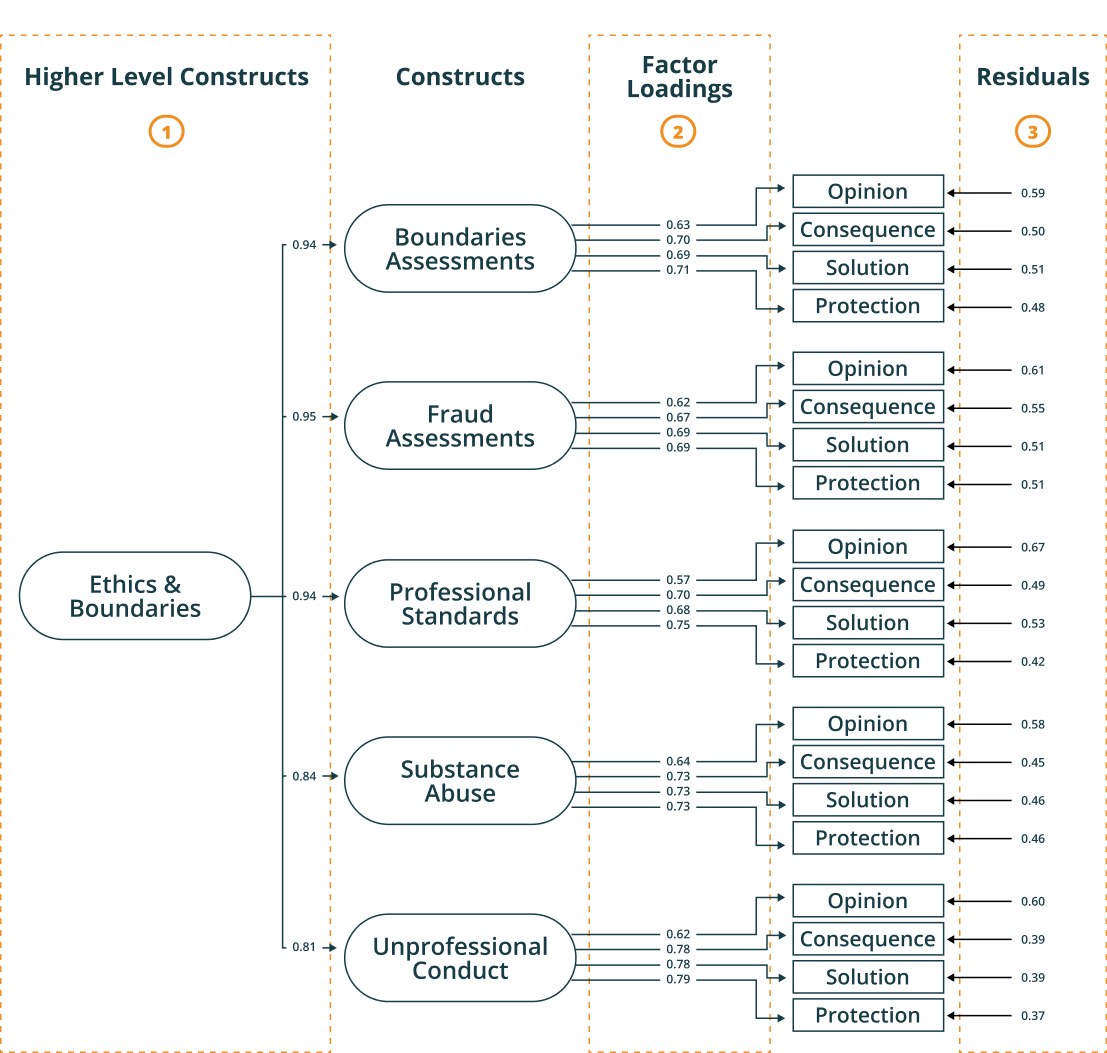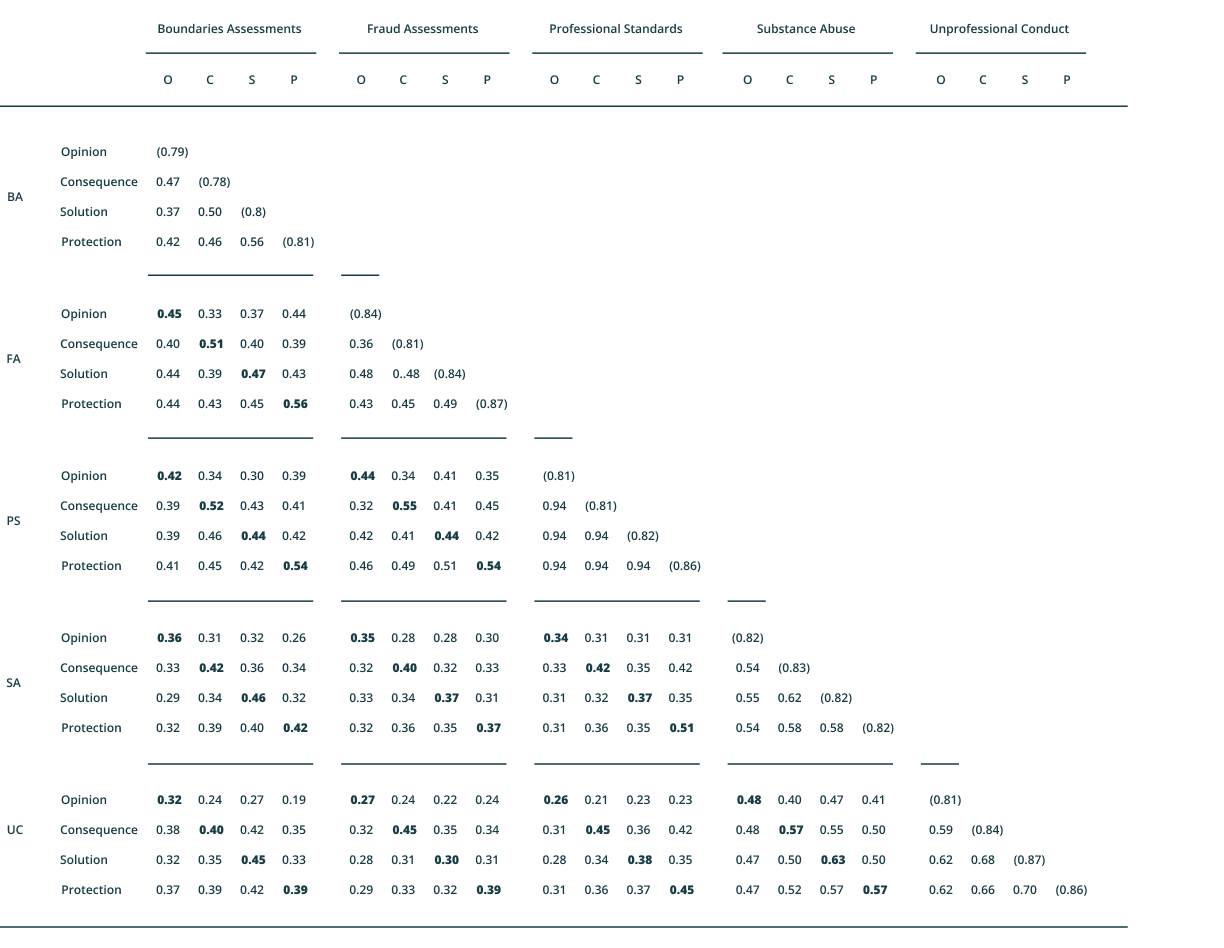The Ethics and Boundaries Assessment (EBAS) is designed to measure how well professionals understand and respond to ethical challenges.
It covers five key areas: Boundaries, Fraud, Professional Standards, Substance Abuse, and Unprofessional Conduct. In this study, over 100 participants completed the full assessment, and each response was scored by multiple trained graders. Overall, the scores were solid as most responses were relevant and thoughtful, showing that the tool can capture a range of ethical thinking and judgment.
100
Participants
562
Total Evaluations
Key Findings
- Excellent Validity and Reliability
- Strong Structure
- Appropriate Dimensionality
Generating Detailed Insights
EBAS uses several research methods to confirm the strength of its design. Together, they show the assessment delivers both detailed category-level insights and a reliable overall picture of ethical awareness.
Confirmatory Factor Analysis
A confirmatory factor analysis tested whether the five domains stand independently while still forming one larger picture of ethical awareness. Results confirmed both: the test provides clarity within each domain and also captures an overall measure of ethical mindset.
Reliability Across Domains
Each domain showed high internal consistency, meaning items within a domain measure the same skill without redundancy. The domains are related yet distinct, striking the right balance of overlap and separation so EBAS captures different dimensions of ethics without repetition.
Item Response Theory
A modern scoring method, item response theory, showed the assessment distinguishes performance across a wide range, from early understanding to advanced reasoning.
Thoughtfully Structured
The EBAS structure is multi-dimensional and unified. Scores can highlight where someone excels or struggles, while an overall score captures their broader ethical approach. This flexibility serves many contexts, from screening to post-violation evaluation.
Recommended Number of Assessments
Research shows EBAS yields the clearest insights when examinees complete at least three assessments during monitoring or remediation. Boards that assign four or more often see stronger results because patterns become clearer and single outliers matter less. Multiple data points create a more consistent picture of ethical reasoning and a more reliable baseline for decisions.
The Evidence-Backed Power of EBAS: A Visual Breakdown
Factor Analysis: Proving Ebas’ Five Distinct Domains

1.
All five domains connect to one overall picture of ethical awareness.
2.
Numbers above 0.6 indicate strong reliability within each domain.
3.
Lower numbers indicate minimal noise and bias across unrelated categories.
What This Means
The factor analysis confirms EBAS measures five distinct ethical domains with strong reliability. Each domain stands on its own while also connecting to a broader picture of ethical awareness. Minimal residuals indicate the assessment avoids bias and redundancy, producing dependable, balanced results.
Multitrait-Multimethod Matric (MTMMM): Confirming Consistency, Validity, Reliability, and Fairness

What This Means
The MTMMM is a psychometric method that checks whether an assessment measures what it claims. For EBAS, the matrix shows:
- Consistency: Responses within each domain line up reliably.
- Validity: The five domains remain distinct, not blurred together.
- Reliability: Patterns hold steady across method variants.
- Fairness: Minimal overlap between unrelated categories reduces bias.
Together, these results confirm EBAS produces trustworthy, repeatable outcomes across professions.
The Bottom Line
EBAS is a trustworthy, research-backed tool that delivers a clear view of ethical decision-making across five key areas.
It is reliable, well structured, and grounded in solid data. For professional regulation, HR, and healthcare administration, it offers a defensible way to measure and support decisions about ethical behavior.








